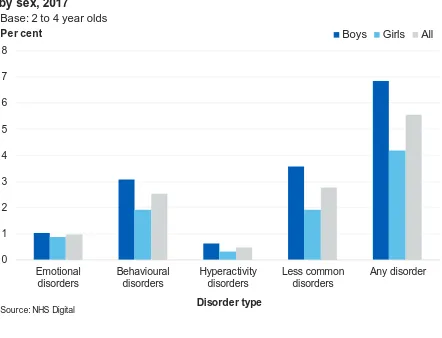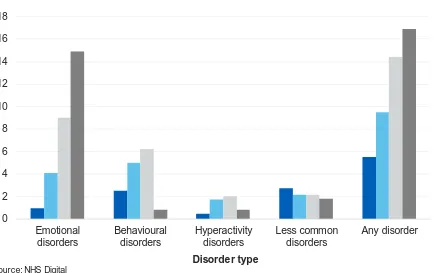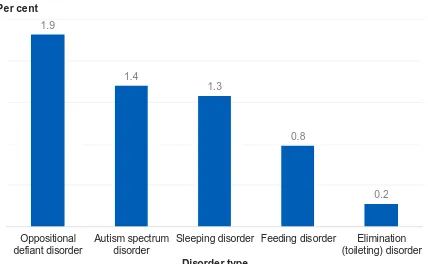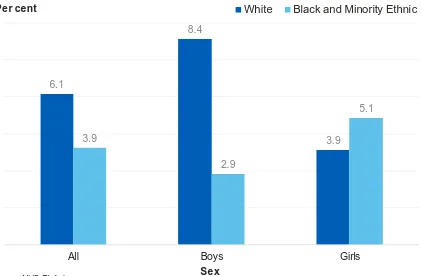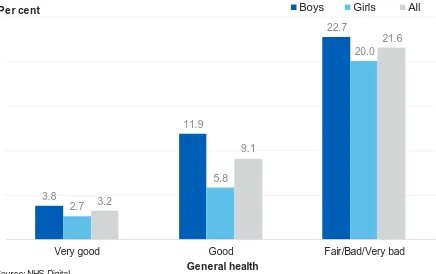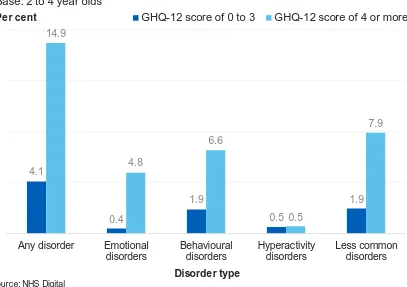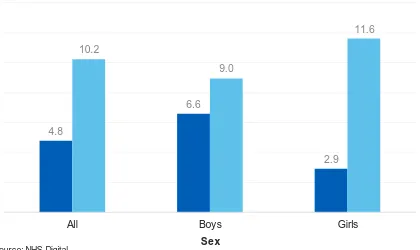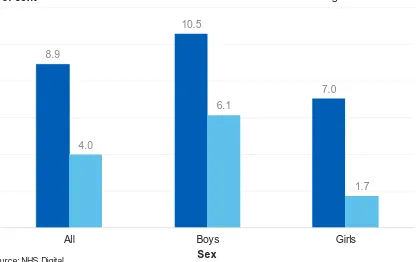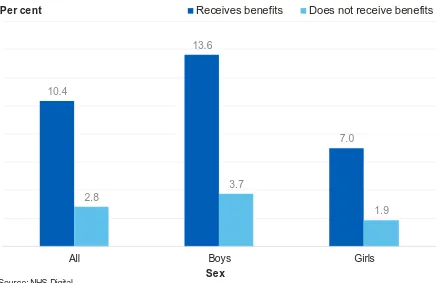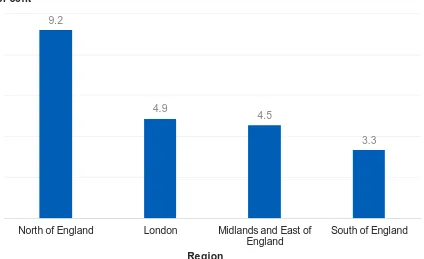This topic report examines the prevalence of mental disorders in preschool
children (2 to 4 year olds) in England in 2017 and the characteristics of
preschool children with a mental disorder. The Development and Well-Being
Assessment (DAWBA) tool was used to assess for a range of mental
disorders.
One in eighteen (5.5%) preschool children were identified with a mental
disorder at the time of interview, with higher rates in boys (6.8%) than in girls
(4.2%).
0 1 2 3 4 5 6 7 8
Emotional disorders
Behavioural disorders
Hyperactivity disorders
Less common disorders
Any disorder Prevalence of mental disorders in preschool children by sex,
2017
Boys Girls All Base: 2 to 4 year olds
Per cent
Disorder type
Source: NHS Digital
Authors: Tim Vizard, Nicola Pearce, Eva Wooding, Jodie Davis, Katharine Sadler, Tamsin Ford, Anna Goodman, Robert Goodman, Sally McManus
Responsible Statistician: Dan Collinson, Community and Mental Health Published: 22 November 2018
Copyright © 2018 Health and Social Care Information Centre.
Mental Health of Children and Young
People in England, 2017
Main findings
Prevalence of mental disorders
• One in eighteen (5.5%) preschool children were experiencing a mental disorder around the time of the interview in England in 2017. Boys (6.8%) were more likely than girls (4.2%) to have a mental disorder
Characteristics of children with a mental disorder
• Demographics: Mental disorders were more common in preschool boys of White ethnic backgrounds (8.4%) than boys of Black or other minority ethnic backgrounds (2.9%). Furthermore, mental disorders were more common in preschool children in the North of England (9.2%) than in other regions
• Health:One in five (21.6%) preschool children whose general health was reported as fair, bad or very bad were identified as having a mental disorder, compared to 3.2% of preschool children whose general health was reported as very good. It should be noted that the mental disorder may have been an aspect of the child’s general health
• Family: Rates of mental disorders were higher in preschool children whose parents showed signs of a common mental disorder (14.9%) and in preschool children living in families with less healthy family functioning (10.2%)
Contents
Main findings 2
Acknowledgements 5
Introduction 6
Background 7
Terminology 8
Prevalence of mental disorders 9
Mental disorders by age and sex 9
Preschool children with a mental disorder 12
Any mental disorder by ethnic group 12
Any mental disorder by child’s general health 13
Any mental disorder by parent’s mental health 14
Any mental disorder by family functioning 15
Any mental disorder by household income 16
Any mental disorder by receipt of benefits 17
Any mental disorder by neighbourhood deprivation 17
Any mental disorder by region 18
Discussion 19
Methods 21
Definitions 23
This is an Experimental Statistics publication
This document is published by NHS Digital, part of the Government Statistical Service.
Experimental statistics are official statistics which are published in order to involve users and stakeholders in their development and as a means to build in quality at an early stage. It is important that users understand that limitations may apply to the interpretation of this data. More details are given in the report.
All official statistics should comply with the UK Statistics Authority’s Code of Practice for Official Statistics which promotes the production and dissemination of official statistics that inform decision making.
Find out more about the Code of Practice for Official Statistics at
https://www.statisticsauthority.gov.uk/code-of-practice/
Find out more about Experimental Statistics at
https://gss.civilservice.gov.uk/wp-content/uploads/2016/02/Guidance-on-Experimental-Statistics_1.0.pdf
This report may be of interest to people working with preschool
Acknowledgements
First of all, we thank all the children, young people, parents and teachers who so generously gave their time to participate in this survey.
Running a national survey relies on the expertise of many people. We thank the professional and committed interviewers, operations department, computing, statistical, and survey and data management staff based at the National Centre for Social Research (NatCen) and the Office for National Statistics (ONS).
In NatCen, we would like to thank Franziska Marcheselli, Dhriti Mandalia, Si Ning Yeoh, Laura Brown, Nikki Leftly, Helen Henderson, Emma Fenn, Susan Corbett, Matt Jonas, Sally Bridges, Rachel Craig, Richard Boreham and Gillian Prior.
In ONS, this survey would not have taken place without the work of Ellie Brodie, Nick Forbes, Charlotte Guinee, Steve Maurice, Simon Robinson, Mark Rowland, Adam White, Alexandra Pop, Salah Merad and Dean Fletcher.
We are also indebted to the team of ONS and NatCen interviewers who spent countless hours interviewing participants who took part in this survey.
Clinical raters undertook the enormous task of reviewing information on all the children and young people who took part. From the University of Exeter College of Medicine and Health these included Carmen Apostu, Pamela Bowman, Tamsin Newlove-Delgado and Oana Mitrofan. From Kings College London: Sophie Epstein, Andrew McWilliams, Helena Hamilton, Christine Kuhn. Thanks to Bruce Clark and the Body Dysmorphic Disorder team from South London and Maudsley Hospital for
independently rating BDD diagnoses.
The survey benefited from an expert steering group, we would like to thank Miranda Wolpert, Peter Fonagy, Catherine Newsome, Lucy Heyes, Helen Duncan, Jessica Sharp, David Lockwood, Jeremy Clark, Alexandra Lazaro, and Nilum Patel.
NHS Digital commissioned the survey series with funding from the Department of Health and Social Care. We are particularly grateful to Dan Collinson, Alison Neave, Steven Webster, Jane Town, Ben Osborne and Kate Croft for their thoughtful
Introduction
Major surveys of the mental health of children and young people in England were carried out in 1999 (Meltzer et al., 2000), 2004 (Green et al., 2005), and 2017. The latest survey was funded by the Department of Health and Social Care, commissioned by NHS Digital, and carried out by the National Centre for Social Research, the Office for National Statistics and Youthinmind.
In each of the three surveys, the Development and Well-Being Assessment (DAWBA) was administered to a stratified probability sample of children and young people and their parents and teachers (for children aged 5 to 19) (Goodman et al., 2000). The 2017 survey was the first in the series to include 2 to 4 year olds, with interviews taking place with the child’s parents only. This follows the adaptation of the DAWBA to include criteria for 2 to 4 year olds (Goodman, 2011).
Cases were reviewed by clinically-trained raters. While many surveys use brief tools to screen for nonspecific psychiatric distress or dissatisfaction, this series applied
rigorous, detailed and consistent methods to assess for a range of different types of disorder according to the International Classification of Disease (ICD-10) diagnostic criteria (WHO, 1992).
Due to the challenges of measuring the rate of mental disorders in this age group, the figures presented in this topic report have been labelled as “Experimental Statistics”. Experimental statistics are official statistics that are published to involve users and stakeholders in their development, and to introduce quality at an early stage.
This topic report examines the:
• Prevalence of mental disorders in 2 to 4 year olds, by age and sex
• Health, social, and economic characteristics of preschool children with a mental disorder, compared to those without
As well as a Summary Report, a series of other topic reports are available focusing on children and young people aged 5 to 19 years old. These are:
• Trends and characteristics
• Emotional disorders
• Behavioural disorders
• Hyperactivity disorders
• Autism spectrum, eating and other less common disorders
• Predictors of mental disorders (to be released at a later date)
• Multiple conditions and wellbeing
• Professional services, informal support and education
• Behaviours, lifestyles, and identities
Further information about the survey and methods can be found in the Survey Design and Methods Report. All reports and associated tables are available at:
Background
Early childhood is considered to be the most important developmental phase for children and is critical for a child’s development and life course (Irwin et al., 2007). During this phase a child develops language, the capacity to form and maintain positive relationships with others, and emotional wellbeing. Identifying mental
disorders in children at an early stage is therefore important as good mental health is a foundation for lifelong emotional and physical health as well as education and economic achievement (Wave Trust, 2013).
The presence of mental disorders in early childhood has been recognised as an important area of research which has not yet received sufficient attention (Gleason et al., 2010). Exploring mental disorders in preschool children is challenging because existing diagnostic systems are not necessarily appropriate given the rapid
development that these children experience (Egger & Angold, 2006). This report makes use of the DAWBA, which accounts for the age appropriate symptoms that may vary according to the maturity of the child (Goodman, 2011).
Figures from NHS Digital reveal that of 271,998 children and young people (2 to 19 years old) in England who were in contact with mental health services, 6,483 were aged 2 to 4 years old1. Whilst this provides an estimate of young children in contact
with mental health services, it will be an underestimate of the number of preschool children experiencing mental disorders in England.
In this report, mental disorders are identified based on the tenth edition of the International Classification of Mental and Behavioural Disorders (ICD‑10) (WHO, 1992). The disorder groupings used in this report are:
• Emotional disorders:These include a range of anxiety and depressive disorders that manifest themselves through fears or sadness which are in excess of the levels expected in preschool aged children. In addition, these fears and feelings of sadness impair the child’s ability to function
• Behavioural disorders: These are characterised by repetitive and persistent patterns of disruptive and violent behaviour which exceed age-appropriate societal norms
• Hyperactivity disorders: These are characterised by developmentally
inappropriate patterns of inattention, impulsivity, and hyperactivity. Children with hyperactivity disorders may find it hard to sit still, act without thinking first, and not finish the things they start. While most children behave like this sometimes, for those with hyperactivity disorders these symptoms are marked, persistent and
cause problems in more than one setting, such as at nursery, at home and in social situations
• Less common disorders: In addition to emotional, behavioural and hyperactivity disorders, a number of less common mental and neurodevelopmental conditions were also assessed. These included: autism spectrum disorders, eating disorders, tic disorders, and several very low prevalence conditions such as psychosis, stereotypic movement disorder, selective mutism, and attachment disorders. Feeding, sleeping, and toileting disorders are also included in this report as they are unique to children of preschool age
Terminology
In this report, the term ‘preschool’ is used to describe children who were aged 2 to 4 at 31st August 2017 and generally refers to the period prior to compulsory school age2.
Children aged 0 to 2 are not included in this report.
The term ‘mental disorder’ is also used, although we are sensitive to the negative connotations this word can have. It is used because the survey did not just screen for general mental health problems, but applied operationalised diagnostic criteria for specific disorders (see the Survey Design and Methods Report for detail).
2 A child reaches compulsory school age on the prescribed day following their fifth birthday (or on their fifth birthday if it falls on a prescribed day). The prescribed days are 31 December, 31 March and 31 August.
Prevalence of mental disorders
For a child to be classified with a disorder they had to meet diagnostic criteria for at least one emotional, behavioural, hyperactivity, or less common disorder around the time of the interview.
Mental disorders by age and sex
One in eighteen (5.5%) preschool children experienced a mental disorder around the time of the interview in England in 2017. This is an estimate based on a sample. If all preschool children in the population had participated, it is likely that the proportion identified with at least one disorder would have been between 4.3% and 6.8%. This range is referred to as the 95% confidence interval (CI). If the sample had been drawn twenty times, for nineteen of those we would expect the estimate to be in this range3.
Boys were more likely than girls to have any type of disorder, with 6.8% of boys and 4.2% of girls identified as having a mental disorder. Less common disorders and behavioural disorders were the most common disorder types in preschool children (2.8% and 2.5% respectively). (Figure 1; Table 1)
3 See the Methods section of this report and the Survey Design and Methods Report for further confidence interval information for the estimates presented in this report.
0 1 2 3 4 5 6 7 8
Emotional disorders
Behavioural disorders
Hyperactivity disorders
Less common disorders
Any disorder Figure 1: Prevalence of mental disorders in preschool children
by sex, 2017
Boys Girls All Base: 2 to 4 year olds
Per cent
Disorder type
[image:9.595.75.517.390.728.2]Overall, preschool children were less likely to have a disorder than older children. When looking at differences between preschool children (2 to 4 year olds) and children of primary school age (5 to 10 year olds), the rate of any mental disorder increased from 5.5% to 9.5%. This change was mainly a result of an increase in the rate of emotional disorders (from 1.0% to 4.1%), and behavioural disorders (2.5% to 5.0%). However, caution is advised when interpreting these results as this increase could also be attributed to the inclusion of a teacher assessment for 5 to 10 year olds. (Figure 2; Table 1)
Specific mental disorders
This survey also examined the prevalence rates of specific mental disorders4. Figure 3
presents the prevalence rates for some of the most common disorders identified in preschool children, alongside disorders which were unique to the preschool population (such as feeding, sleeping, and toileting disorders). Differences between boys and girls are not discussed, due to the small sample sizes in this age group.
The main disorders identified in preschool children were oppositional defiant disorder (1.9%)5, autism spectrum disorder (1.4%)6, sleeping disorder (1.3%)7, and feeding
4 See the Definitions section of this report for more information on the specific mental disorders.
5 The proportion of children with oppositional defiant disorder was likely to be between 1.2% and 2.5%.
6 The proportion of children with autism spectrum disorder was likely to be between 0.7% and 2.0%.
7 The proportion of children with sleeping disorder was likely to be between 0.7% and 1.8%. 0 2 4 6 8 10 12 14 16 18 Emotional disorders Behavioural disorders Hyperactivity disorders Less common disorders Any disorder Figure 2: Prevalence of mental disorders by age, 2017
2 to 4 year olds 5 to 10 year olds 11 to 16 year olds 17 to 19 year olds Base: 2 to 19 year olds
Per cent
Disorder type
[image:10.595.83.517.270.543.2]disorder (0.8%)8. Elimination (toileting) disorder was present in about 0.2%9 of
preschool children. (Figure 3; Table 2)
Due to the challenges associated with identifying the presence of feeding, sleeping and elimination (toileting) disorders in preschool children, diagnostic classification systems were not used for these disorders. Instead raters identified preschool children who would plausibly justify referral to specialist services. This was based on parents’ reports of persistent and distressing difficulties experienced by the child which also impaired the child’s ability to function.
8 The proportion of children with feeding disorder was likely to be between 0.3% and 1.2%.
9 The proportion of children with elimination (toileting) disorder was likely to be between 0% and 0.4%.
1.9
1.4
1.3
0.8
0.2
Oppositional defiant disorder
Autism spectrum disorder
Sleeping disorder Feeding disorder Elimination (toileting) disorder Figure 3: Specific mental disorders in preschool children, 2017
Base: 2 to 4 year olds
Per cent
Disorder type
[image:11.595.81.509.275.539.2]Preschool children with a mental disorder
Any mental disorder by ethnic group
There was an association between ethnic group and the presence of a mental
disorder in preschool children. Mental disorders were more common in boys of White ethnic backgrounds (8.4%) than boys of Black or other minority ethnic backgrounds (2.9%). Rates of mental disorders were similar in girls of white ethnic backgrounds and girls of black or other minority ethnic backgrounds. (Figure 4; Table 3)
6.1
8.4
3.9 3.9
2.9
5.1
[image:12.595.85.506.273.549.2]All Boys Girls
Figure 4: Any mental disorder in preschool children by ethnic group and sex, 2017
White Black and Minority Ethnic Base: 2 to 4 year olds
Per cent
Sex
Any mental disorder by child’s general health
A child’s general health was associated with the presence of a mental disorder. Figure 5 shows that children with poorer general health had higher rates of mental disorders. One in five (21.6%) preschool children whose general health was reported as fair, bad or very bad were identified as having a mental disorder, compared to 3.2% of
preschool children whose general health was reported as very good. (Figure 5; Table 4)
It should be noted that when the parents assessed general health they are likely to have considered both the child’s mental health and their physical health.
3.8
11.9
22.7
2.7
5.8
20.0
3.2
9.1
21.6
Very good Good Fair/Bad/Very bad
Per cent
[image:13.595.80.516.262.536.2]General health
Figure 5: Any mental disorder in preschool children by child's general health and sex, 2017
Boys Girls All
Base: 2 to 4 year olds
Any mental disorder by parent’s mental health
Preschool children of parents who showed signs of a common mental disorder (indicated by a General Health Questionnaire (GHQ-12) score of 4 or more) were three and a half times more likely to be identified with a mental disorder (14.9%) than children whose parents were not considered to have a common mental disorder (GHQ-12 score between 0 and 3) (4.1%).
Children of parents who were likely to have a common mental disorder showed higher rates of emotional disorders, behavioural disorders and less common disorders, however the rate of children with hyperactivity disorder was not affected. Specifically, children of parents who showed signs of a common mental disorder were 12 times more likely to have an emotional disorder than children of parents who did not show signs of a common mental disorder (4.8% and 0.4% respectively). (Figure 6; Table 5)
As a cross-sectional survey, these associations cannot explain causality. While the presence of a mental disorder in parents may contribute to the development of mental disorders in preschool children, the presence of mental disorders in preschool children may affect the mental health of parents.
4.1
0.4
1.9
0.5
1.9 14.9
4.8
6.6
0.5
7.9
Any disorder Emotional disorders
Behavioural disorders
Hyperactivity disorders
Less common disorders
[image:14.595.85.492.340.627.2]Per cent
Figure 6: Any mental disorder in preschool children by parent's mental health, 2017
GHQ-12 score of 0 to 3 GHQ-12 score of 4 or more Base: 2 to 4 year olds
Source: NHS Digital
Any mental disorder by family functioning
Children living in families with less healthy functioning (a score of 2.01 or more) were more likely to have a mental disorder (10.2%) than children living in families with healthier functioning (a score of 2.00 and less) (4.8%).
Figure 7 shows that 11.6% of girls living in families with less healthy functioning had a mental disorder, compared to 2.9% of girls living in families with healthier functioning. Comparatively, 9.0% of boys living in families with less healthy family functioning had a mental disorder compared to 6.6% of boys living in families with healthier
functioning. (Figure 7; Table 6)
As a cross-sectional survey, these associations cannot explain causality. While problems with family functioning may contribute to the onset of a mental disorder, the presence of a mental disorder could also lead to problems with family functioning.
4.8
6.6
2.9 10.2
9.0
11.6
[image:15.595.86.506.327.577.2]All Boys Girls
Figure 7: Any mental disorder in preschool children by family functioning score and sex, 2017
Healthier family functioning Less healthy family functioning Base: 2 to 4 year olds
Per cent
Sex
Any mental disorder by household income
Equivalised household income was associated with the prevalence of mental
disorders in preschool aged children. Children living in the third of households with the lowest income had a mental disorder rate of 8.9% compared to 4.0% of children in other households. Girls living in households with the lowest income were four times more likely to have a mental health disorder (7.0%) than girls in households with the highest income (1.7%). (Figure 8; Table 7)
8.9
10.5
7.0
4.0
6.1
1.7
[image:16.595.86.506.275.537.2]All Boys Girls
Figure 8: Any mental disorder in preschool children by equivalised household income and sex, 2017
Lowest tertile Highest / Middle tertile Base: 2 to 4 year olds
Per cent
Sex
Any mental disorder by receipt of benefits
Preschool children who lived with a parent in receipt of benefits related to low income, and disability, were about three and a half times more likely to have a mental disorder (10.4%) than children whose parents were not receiving these benefits (2.8%). This same pattern was seen in boys and in girls. (Figure 9; Table 8)
Any mental disorder by neighbourhood deprivation
There was no association between neighbourhood deprivation and the presence of a mental disorder in preschool children. (Table 9)
10.4
13.6
7.0
2.8
3.7
1.9
All Boys Girls
Per cent
[image:17.595.77.515.230.513.2]Sex
Figure 9: Any mental disorder in preschool children by receipt of low income or disability related benefits, 2017
Receives benefits Does not receive benefits Base: 2 to 4 year olds
Any mental disorder by region
Region was associated with the presence of any mental disorder. Mental disorders were more common in preschool children in the North of England (9.2%) than in other regions. (Figure 10; Table 10)
9.2
4.9
4.5
3.3
North of England London Midlands and East of England
[image:18.595.87.511.225.484.2]South of England Figure 10: Any mental disorder in preschool children by
region, 2017
Base: 2 to 4 year olds
Per cent
Region
Discussion
This topic report presents experimental findings on the rates of mental disorders in children aged 2 to 4, offering a rare insight into the prevalence and distribution of mental disorders in preschool aged children.
The presence of mental disorders in early childhood has been recognised as an important area which has not received sufficient attention (Gleason et al., 2010). The first few years of a child’s life is critical to their future mental, social and emotional development (Stewart-Brown & Schrader-McMillan, 2011). Identifying mental disorders in preschool children is challenging due to the rapid developmental stage preschool children experience, and the appropriateness of existing diagnostic systems to account for this developmental variation (Egger & Angold, 2006).
This survey found that the rates of mental disorders were higher in primary school aged children (5 to 10 years old) compared to preschool aged children, with further increases in older age groups. This was partially a result of preschool children rarely meeting diagnostic criteria for some disorders, or difficulty in demonstrating long standing impairment or pervasiveness. However, a poll by the Anna Freud National Centre for Children and Families (AFNCCF, 2017) found that 92% of primary school teachers in England feel that primary schools have a crucial role to play in
identifying pupils with mental health issues, highlighting the importance of understanding mental disorders in children at a young age.
The survey found that mental disorders were more common in boys than girls of preschool age. Gender role socialisation begins in the first months of life (Bronstein, 2006), with parent-child conversations about emotions often differing depending on gender from early on (Hamblin, 2016).The findings of this survey echo results from the Early Years Foundation Stage (EYFS) profile10 which showed that 90% of girls and
80% of boys reached the expected level in personal, social and emotional development by the time they turned 5 years old (DfE, 2017).
Children of parents who had poor mental health were three and a half times more likely to be identified with a mental disorder than children whose parents showed little to no evidence of a mental disorder. There is substantial evidence that maternal depression and anxiety increases the risk of mental disorder among children
(Goodman et al., 2011). Research has shown that 3.9 per cent of new or expectant mothers in 201711 were in contact with secondary mental health services, with young
mothers (particularly those aged 16 or under) most likely to be in contact with these
10 Early years foundation stage EYFS Profile is a teacher assessment of children’s development at the end of the EYFS (the end of the academic year in which the child turns five). The assessment
considered emotional wellbeing, positive relationships and self-confidence.
11For further information on the definition of perinatal period, see
services (NHS Digital, 2018). The Government’s Maternal Mental Health Pathway12
sets out how, by 2021, specialist perinatal mental health services will support an additional 30,000 women each year to receive evidence-based treatment. Research also suggests an association between depressive symptoms in fathers and depressive symptoms in their adolescent children (Lewis et al., 2017), highlighting the importance of treating depression in both parents.
This report has also highlighted the relationship between higher rates of mental disorders in children living in families with unhealthy family functioning. Children who are exposed to negative parenting, relationships and other early-life adversities are at risk of mental health problems in later life (HM Government, 2011), highlighting the importance of good parent-child relationships in promoting positive outcomes in children.
This survey has shown children from low income households had the highes t rates of mental disorders. By school age there are wide variations in children’s abilities, with children from poorer backgrounds typically exhibiting worse cognitive and behavioural performance than children from more affluent homes (Field, 2010). Research has indicated that interventions targeting poorer children’s outcomes are more likely to be successful if they target a wide range of issues (Field, 2010).
This report presents the rates of mental health disorders in preschool children based on an experimental method. They have been published to enable debate and further investigation into this area of children’s mental health. The research presented in this report has shown the importance of early identification of issues in children, and this report provides a unique insight into the mental health of preschool children.
Methods
The Mental Health of Children and Young People (MHCYP) survey was conducted with 5 to 15 year olds living in Britain in 1999 and 5 to 16 year olds living in Britain in 2004. The 1999 and 2004 surveys sampled from Child Benefit records. For the 2017 survey a stratified multistage random probability sample of 18,029 children was drawn from NHS Patient Register in October 2016. Children and young people were eligible to take part if they were aged 2 to 19, lived in England, and were registered with a GP. Children, young people and their parents were interviewed face-to-face at home using a combination of Computer Assisted Personal Interview (CAPI) and Computer
Assisted Self Interview (CASI), between January and October 2017. A short paper or online questionnaire was completed by a nominated teacher for children aged 5 to 16 years old. Data collection varied with the selected child’s age:
• 2 to 4 year olds: parent interview
• 5 to 10 year olds: parent interview and teacher interview
• 11 to 16 year olds: parent interview, child interview and teacher interview
• 17 to 19 year olds: young person interview and parent interview (if parent present at the same address)
Productive interviews (involving one or more participants in each household) were achieved for 9,117 children (1,463 2 to 4 year olds; 3,597 5 to 10 year olds; 3,121 11 to 16 year olds; 936 17 to 19 year olds), and 3,595 teachers (54% of eligible children). The survey included the detailed and comprehensive Development and Well-Being Assessment (DAWBA). This allowed the assessment of emotional, hyperactivity, behavioural and less common disorders, like autism. The DAWBA was used for all age groups in the sample, however with special adjustments to ensure
age-appropriate criteria were used for preschool children (Goodman, 2011). These included:
• Some sections of the 5 to 19 DAWBA were not included because relevant
disorders are so rare in 2 to 4 year olds that they are almost never encountered in specialist clinics, let alone in general population samples
• Other sections have been added to cover disorders that are particularly relevant to 2 to 4 year olds, namely: feeding disorders; sleep disorders; and elimination
disorders
• Adjustments were also needed for areas that are relevant both in the early years and in later childhood since the characteristic symptoms may vary according to the maturity of the child. In the early years, for example, evidence of post-traumatic stress disorder (PTSD) is more likely to include repetitive play or drawing related to the trauma
After interviews were complete, a team of eleven trained clinical raters reviewed the data to reach disorder ratings for each participant. Raters applied the diagnostic criteria for specific disorders set out in the tenth International Classification of Disease (ICD-10) (WHO, 1992) and the Diagnostic and Statistical Manual of Mental Disorders (DSM–5) (APA, 2013). Diagnostic classification systems were not used to diagnose the feeding, sleeping and elimination disorders as this was experimental work to see what proportion of families have problems in these domains that sound as if they would plausibly justify referral to specialist services.
While this report covers the mental health of 2 to 4 year olds, this does still leave the period from 0 to 23 months uncovered. Ongoing research on “infant psychiatry” may one day allow this important developmental period to be covered by high-quality survey instruments, but at present this is an aspiration rather than something that can be delivered in the near future (Goodman, 2011).
Ratings for 2 to 4 year olds have been based on a single informant (the parent of the sampled child). Caution is advised when interpreting these results as the increases in rates by age could also be attributed to the inclusion of a teacher assessment for 5 to 16 year olds. More comprehensive multi-informant data increases the likelihood of clinical raters having enough information to identify a mental disorder. It is therefore plausible that a modest increase may be seen in the prevalence of disorders with the presence of a teacher assessment.
The 2017 analyses are based on participants’ age at 31st August 2017. This allowed
for consistency, with participants grouped with their peers in terms of school year.
Confidence intervals
Information about confidence intervals are presented in the text and described as the range for which a value is likely to fall within had the whole population participated in this survey rather than a sample. This range was calculated based on 95% confidence interval and indicates the range we would expect estimates to fall within nineteen times in twenty, if the study was repeated with new samples.
Definitions
Mental disorder
Mental disorders were identified on the survey according to the standardised diagnostic criteria in the tenth edition of the International Classification of Diseases (ICD-10). Specific mental disorders were grouped into four broad categories:
[image:23.595.61.555.265.623.2]emotional, behavioural, hyperactivity and other less common disorders. While some of the symptoms covered in this report may be present in many children, to count as a disorder they had to be sufficiently severe to cause distress to the child or impair their functioning (WHO, 1993).
Figure 11: Disorders included in 2017 survey
Any mental disorder
Disorder categories
Emotional disorders Hyperactivity
disorders Behavioural (or ‘conduct’) disorders Other less common disorders Disorder subgroups
Anxiety disorders Depressive
Emotional disorders
Emotional disorders include a range of different types of anxiety disorder
(characterised by fear and worry), depressive disorder (characterised by sadness, loss of interest and energy, and low self-esteem) and a small number of cases of
mania and bipolar affective disorder.
Anxiety disorders
Anxiety disorders are a type of emotional disorder characterised by excessive feelings of fear and distress, often accompanied by physiological symptoms.
Separation anxiety disorder
The focus of the anxiety is on the fear of separation from attachment figures.
Symptoms include clinging to parents, extreme and severe crying, refusal to do things that require separation, and physical illness such as headaches or vomiting. Some of these behaviours are normal among very young children, but if severe and persistent they impede the child’s development and ability to cope.
Generalised anxiety disorder
Anxiety that is generalised and persistent which is not restricted to, or dominated by, any particular circumstance. Symptoms include persistent nervousness, trembling, sweating and dizziness. Symptoms must be present on most days for a period of at least six months.
Specific phobia
Specific phobias are incapacitating fears that are restricted to highly specific objects or situations, for example heights, thunder, darkness, or certain animals. A fear becomes phobic when the severity of difficulties stops the child from being able to cope with normal everyday activities.
Social phobia
Fear of scrutiny by other people leading to avoidance of social situations. More pervasive social phobias are usually associated with low self-esteem and fear of criticism. The symptoms may progress to panic attacks.
Agoraphobia
Post-traumatic stress disorder
A delayed response to a stressful event or situation that was exceptionally threatening or catastrophic. Typical features include reliving the event including flashbacks,
nightmares and night terrors, as well as avoidance of memories or situations that trigger memories of the event with emotional numbing and hypervigilance for danger.
Other anxiety disorder
Disorders where the main symptom is anxiety that causes significant distress or prevents the child from coping, but does not meet the diagnostic criteria for any of the other specific anxiety disorders reported on. Children often exhibit some of the
characteristics of more than one sub-type of anxiety disorder and are very distressed or struggling with to cope.
Depressive disorders
Characterised by sadness, loss of interest or pleasure, feelings of guilt or low self-worth, disturbed sleep or appetite, feelings of tiredness, and poor concentration. Depression can be long lasting, recurrent and substantially impair functioning at school and in daily life (WHO, 2017).
Major depressive episode
Characterised by persistent feelings of sadness, anxiety or feeling ‘empty’, loss of interest or pleasure in hobbies, difficulty concentrating, loss of appetite and decreased energy. The number of symptoms present and the level of impairment to everyday functioning determines whether a child is diagnosed with a mild depressive episode, moderate depressive episode, or severe depressive episode based on the ICD-10 classification.
Other depressive episode
Depression which is not typical of a major depressive episode. Symptoms have not been present long enough or are not severe enough to be classified as a major depressive episode, but are causing significant distress or impairment.
Bipolar affective disorder and manic episode
Behavioural disorders
A group of disorders characterised by repetitive and persistent patterns of disruptive and violent behaviour in which the rights of others, and social norms or rules, are violated. The umbrella term used in ICD-10 is conduct disorders, in this report we have used the term ‘behavioural disorders’ to avoid confusion with the sub-types of disorder included in the survey.
Oppositional defiant disorder (ODD)
Oppositional defiant disorder (ODD) is more common among younger children, partly because of the types of behaviour involved. ODD is characterised by temper
outbursts, arguing with adults, disobedience, deliberately annoying others, passing on blame, being easily annoyed, resentful, spiteful and vindictive.
Conduct disorder confined to family
In this condition, the challenging behaviour is entirely, or almost entirely, confined to the home and to interactions with members of the immediate family or household.
Unsocialised conduct disorder
A behavioural disorder characterised by the combination of persistent dissocial or aggressive behaviour with significant pervasive abnormalities in the individual's relationships with other children, such that they have no friends.
Socialised conduct disorder
Disorder involving persistent dissocial or aggressive behaviour occurring in individuals who are generally well integrated into their peer group.
Other conduct disorders
Any other type of behaviour (or ‘conduct’) disorder that is impairing, but does not fit the criteria for one of the other specific types reported on. Children often exhibit some of the characteristics of two or more of the sub-types of conduct disorder.
Hyperactivity disorders
These are characterised by developmentally inappropriate levels of inattention, impulsivity, and hyperactivity.
Hyperkinetic disorder
In hyperkinetic disorder, children have levels of inattention, hyperactivity and
Other hyperactivity disorders
Other hyperactivity disorders are diagnosed if a child or young person met nearly all the criteria for hyperkinetic disorder, but just miss the full diagnostic criteria and are unable to function. For example, they have display five rather than six difficulties with attention or an age of onset after the age of seven.
Less common disorders
A number of less common mental and neurodevelopmental conditions were also identified on the survey. These included: autism spectrum disorders (ASD), eating disorders, tic disorders, and a number of very low prevalence conditions such as psychosis, stereotypic movement disorder, selective mutism, and attachment disorders. Feeding, sleeping, and toileting disorders were also assessed in the preschool population.
Autism spectrum conditions (ASC) and autism spectrum disorder (ASD)
These terms are both used to indicate a number of disorders characterised by severe impairment in social interaction, communication, and the presence of stereotyped behaviours, interests, and activities. ‘Pervasive developmental disorder’ (PDD) is used in the ICD classificatory system, but was replaced in the Diagnostic and Statistical Manual (DSM-5) with ASD, the term used most in this report. The category as used here consists mostly of ICD-10 classifications of autism and Asperger’s syndrome, but also some cases of other pervasive developmental disorders. Symptoms include: language problems, difficulty relating to other people, unusual forms of play, difficulty with changes in routine, and repetitive movements or behaviour patterns.
Tic disorder
Tics are fast, repetitive muscle movements that result in sudden and difficult to control body jolts or sounds. Tourette's syndrome involves vocal and motor tics that have persisted for over a year.
Feeding disorder
In preschool children feeding disorder generally involves food refusal and extreme faddiness in the presence of an adequate food supply, a reasonably competent caregiver, and the absence of organic disease.
Sleeping disorder
Eliminating (toilet) disorder
Although it is normal for children of preschool age to experience the occasional accident, toilet (elimination) disorders occur in children who repeatedly experience problems going to the bathroom - both defecating and urinating.
Other less common disorders
Psychosis involves a disturbed relationship with reality. A person who is experiencing psychosis may hear, see or feel things that are not really there or experience beliefs that are difficult to shake but are not grounded in reality. There are various different types of psychosis, including schizophrenia, which are extremely rare in children and young people.
Stereotypic movement disorder is diagnosed in children who undertake repetitive, purposeless movements that are distressing or impede functioning. This rare condition mostly occurs in children and young people who have intellectual disability or
neurodevelopmental disorders such as ASC.
Selective mutism is a rare difficulty with social functioning with an onset in childhood in which a child who understands language and can speak when with family and close friends is unable to speak in almost all social situations.
Attachment disorders also involve impairing difficulty with social function that have their onset in childhood. They are believed to result from significant neglect and abuse from care-givers. Children with these disorders struggle to interact with others,
displaying a range of abnormal social behaviours from inappropriate friendliness towards everyone they meet to highly withdrawn and hypervigilance. These
behaviours occur across situations and with many people and should not be confused with attachment, secure or otherwise, which describes the relationship between a child and a particular care-giver.
Analysis variables
Ethnic group
Ethnic group was self-reported directly by children and young people aged 11 or more, and by parents for children aged 10 or under.
Special educational needs
Presence of special educational needs was based on information provided by the interviewed parent for children aged 2 to 16 and for young people aged 17 to 19.
Child’s general health
Parental mental health
The mental health of the interviewed parent or guardian (usually the mother), was assessed using the GHQ-12. Scores range from 0 (no psychological distress) to 12 (severe psychological distress). A score of 4 or more is generally considered indicative of the presence of a common mental disorder.
Family functioning
Family functioning was measured using the General Functioning Scale of the
McMaster Family Activity Device (FAD). It comprises 12 statements that parents rate on a four point scale. A score was derived. A score above 2 was considered to indicate ‘unhealthy’ family functioning.
Equivalised household income
An estimate of overall household income was established by means of a showcard, and was adjusted to reflect the number and ages of people living in the hous ehold. For further details please refer to the Survey Design and Methods Report.
Welfare benefits
A household was classified as in receipt of 'low income benefits' if any resident adult with parental responsibility for the child reported being in receipt of any of: Housing Benefit, Working Tax Credit, Income Support, Universal Credit (UC), Job Seekers' Allowance, or Pension Credit. Child Tax Credit did not count as the eligible income threshold for this is higher. While UC could be received for disability-related reasons this was not distinguishable in the data collected.
A household was classified as in receipt of 'disability-related benefits' if an adult with parental responsibility for the sample child received any of: Disability Living Allowance, Carer's Allowance, Employment and Support Allowance, Personal Independence Payment, Industrial Injuries Disablement Benefit, Severe Disablement Allowance, Incapacity Benefit, Armed Forces Compensation Scheme, or Attendance Allowance.
Neighbourhood deprivation
The Index of Multiple Deprivation (IMD) 2015 combines a number of indicators, chosen to cover a range of economic, social and housing issues, into a single
Region
The regional measure in this topic report was based on Public Health England (PHE) regions:
• London (integrated region and centre)
• North of England
• Midlands and East of England
• South of England
This differs from the use of Government Office Regions in other topic reports. Regions were grouped in this way due to small sample sizes in each Government Office
References
American Psychiatric Association. (2013). Diagnostic and statistical manual of mental disorders (5th ed.). Arlington: American Psychiatric Publishing
Anna Freud National Centre for Children and Families (AFNCCF). Teachers identify training gap in mental health. 2017. [ONLINE] Available at:
https://www.annafreud.org/insights/news/2017/09/teachers-identify-training-gap-in-mental-health/. [Accessed 4 September 2018]
Bronstein, P. (2006). The family environment: Where gender role socialization begins. In Worell, J., and Goodheart, C.D. (eds.), Handbook of girls’ and women’s
psychological health: Gender and wellbeing across the lifespan (pp. 262-271). New York, NY, US: Oxford University Press
Department for Education (DfE). Early years foundation stage profile results: 2016 to 2017. [ONLINE] Available at: https://www.gov.uk/government/statistics/early-years-foundation-stage-profile-results-2016-to-2017. [Accessed 4 September 2018] Egger, H.L. and Angold, A. (2006). Common emotional and behavioral disorders in preschool children: Presentation, nosology, and epidemiology. Journal of Child Psychology and Psychiatry, 47(3-4), pp. 313-337
Field, F. (2010). The Foundation Years: preventing poor children becoming poor adults. The Report of the Independent Review on Poverty and Life Chances. The Stationery Office.
Gleason, M., Zeanah, C., and Dickstein, S. (2010). Recognizing Young Children In Need Of Mental Health Assessment: Development And Preliminary Validity Of The Early Childhood Screening Assessment. Infant Mental Health Journal, 31(3), pp. 335-357
Goodman, R. (2011). Assessing preschool children’s emotional and behavioural
adjustment. [ONLINE] Available at:
http://www.dawba.info/EarlyYears/EarlyYearsDAWBAReport9jan11.pdf [Accessed 4 September 2018]
Goodman, R., Ford, T., Richards, H., et al. (2000). The Development and Well-Being Assessment: description and initial validation of an integrated assessment of child and adolescent psychopathology. The Journal of Child Psychology and Psychiatry and Allied Disciplines, 41(5), pp. 645-655
Goodman, S.H., Rouse, M.H., Connell, A.M., et al. (2011). Maternal depression and child psychopathology: A meta-analytic review. Clinical Child and Family Psychology Review, 14(1), pp. 1-27
Hamblin, E. (2016). Gender and children and young people’s emotional and mental health: manifestations and responses. A rapid review of the evidence. [ONLINE] Available at:
https://www.ncb.org.uk/sites/default/files/field/attachment/NCB%20evidence%20revie w%20-%20gender%20and%20CYP%20mental%20health%20-%20Aug%202017.pdf
[Accessed 4 September 2018]
HM Government. (2011) No health without mental health. [ONLINE] Available at:
https://assets.publishing.service.gov.uk/government/uploads/system/uploads/attachm ent_data/file/215811/dh_124057.pdf [Accessed 4 September 2018]
Irwin, L.G., Siddiqi, A., and Hertzman, C. (2007) Early Child Development: A Powerful Equalizer. Final report for the World Health Organization's Commission on Social Determinants of Health. [ONLINE] Available at:
http://www.who.int/social_determinants/resources/ecd_kn_report_07_2007.pdf
[Accessed 4 September 2018]
Lewis, G., Neary, M., Polek, E., et al. (2017). The association between paternal and adolescent depressive symptoms: evidence from two population-based cohorts. The Lancet Psychiatry, 4(12), pp. 920-926
Meltzer, H., Gatward, R., Goodman, R., et al. (2000). The mental health of children and adolescents in Great Britain. London: The Stationery Office
NHS Digital. (2018). Exploratory Analysis: Women in contact with mental health services who were new or expectant mothers, January 2017 to December 2017, experimental statistics. [ONLINE] Available at:
https://files.digital.nhs.uk/2B/5D61DF/MHSDS%20Perinatal%20Exploratory%20Repor t.pdf [Accessed 4 September 2018]
Stewart-Brown, S.L., and Schrader-McMillan A. (2011). Parenting for mental health: what does the evidence say we need to do? Report of Workpackage 2 of the
DataPrev project. Health Promotion International, 26(1), pp. 10-28
Veale, D. and Matsunaga, H. (2014). Body dysmorphic disorder and olfactory
reference disorder: proposals for ICD-11. Revista Brasileira de Psiquiatria, 36(1), pp. 14-20
Wave Trust. (2013). Conception to age 2 – the age of opportunity. Addendum to the Government’s vision for the Foundation Years: ‘Supporting Families in the Foundation Years’. [ONLINE] Available at:
https://www.1001criticaldays.co.uk/sites/default/files/conception-to-age-2-full-report_0.pdf [Accessed 4 September 2018]
World Health Organization. (1992). The ICD-10 Classification of Mental and
Behavioural Disorders: Clinical descriptions and diagnostic guidelines, WHO: Geneva
www.digital.nhs.uk
0300 303 5678
enquiries@nhsdigital.nhs.uk
@nhsdigital
This publication may be requested
in large print or other formats.
Published by NHS Digital, part of the Government Statistical Service
Copyright © 2018 Health and Social Care Information Centre.
The Health and Social Care Information Centre is a non-departmental body created by statute, also known as NHS Digital.
You may re-use this document/publication (not including logos)
free of charge in any format or medium, under the terms of the Open Government Licence v3.0.
To view this licence visit
www.nationalarchives.gov.uk/doc/open-government-licence
or write to the Information Policy Team, The National Archives, Kew, Richmond, Surrey, TW9 4DU;
